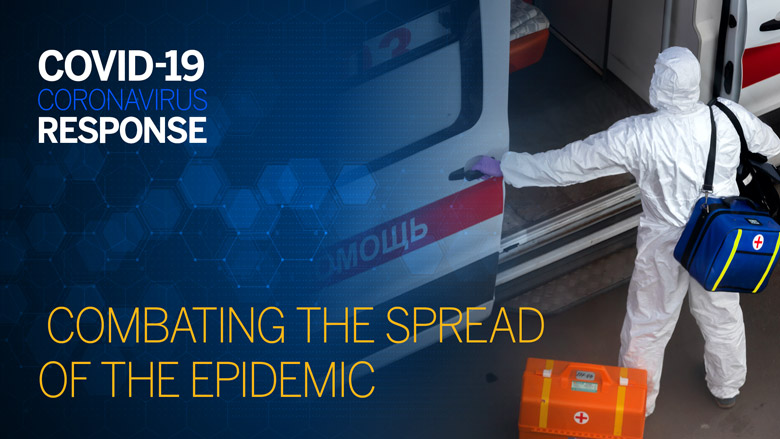
CHALLENGES
Russia is facing massive challenges in successfully battling the COVID-19 pandemic and providing state-of-the-art diagnostics and treatments for citizens. On January 31, 2020, the first two cases of COVID-19 were detected in the Russian Federation. Since then, the virus has been identified in 370,680 people as of May 27, 2020. To date, Russian Government reported 3,968 deaths from COVID-19, the share of deaths in the total number of persons infected is r 0.9 percent. For updated information, please visit: John Hopkins University.
WHAT RUSSIA HAS DONE TO CONFRONT THESE CHALLENGES
The Russian government has taken strong and timely measures to prevent and contain the spread of COVID-19:
The health system has stepped up by strengthening its disease surveillance systems and initiating a rapid increase in testing to ensure the progressive monitoring of the epidemic’s spread. The number of tests has increased from 2,200 per day at the beginning of the crisis to 216,500 per day as of May 11.
Widespread testing, combined with contact tracing and the isolation of patients with COVID-19 in designated health facilities or at home, has been effective in containing the spread of the virus. The country has worked hard to expand the capacity of its public health and primary health care hospitals and laboratories by ensuring that the necessary personnel are in place. Many hospitals have been reorganized to house infection beds fully prepared for the treatment of COVID-19 patients, including with better equipped intensive care units. Additionally, new hospitals have been constructed in some regions, and temporary hospitals for patients with mild symptoms have been set up. More than 130,000 hospital beds have been prepared for COVID-19 patients countrywide.
Enhanced human resources have been put in place, ensuring that there are enough frontline health workers who are well trained in the early detection and treatment of COVID-19 and the use of personal protective equipment (PPE). The network of epidemiologists supporting case investigation and contact tracing at the local and regional levels has been strengthened. Salaries for health workers who treat COVID-19 patients have been increased.
The government has leveraged the private sector for the swift manufacture of ventilators, other medical equipment, and PPE.
For effective communication with the public, continuous online education programs and mass media efforts on COVID-19 prevention measures have been launched. The Ministry of Health, Rospotrebnadzor (the Federal Service for Supervision of Consumer Rights Protection and Human Welfare), and regional health authorities have established call centers to answer questions and provide guidance on COVID-19. The government has also established a communication center «СТОПКОРОНАВИРУС.РФ» that presents a variety of topical information.
The health system response has varied across the country. There have been several serious outbreaks, in particular, in health facilities in a number of regions. Lack of testing capacity, ineffective contact tracing and lack of personal protective equipment for health workers are likely to have contributed to these COVID-19 outbreaks.
WHAT ARE OTHER COUNTRIES DOING?
Containing the disease is the strategy that delivers the largest gains in the immediate term. Testing, tracing, and isolating help to identify and isolate infectious persons, both symptomatic and asymptomatic. This approach has proven effective in reducing the spread of the virus, especially when implemented early. Various forms of lockdowns and social distancing have also been applied in countries across the income spectrum to delay disease spread and slow the inflow of critical-care patients to hospitals (what is known as “flattening the curve”).
Countries that have introduced massive testing and contact tracing, instituted timely quarantine measures and social distancing, rapidly reorganized health facilities and provided rigorous treatment, and retrained and protected human resources in the health care system have demonstrated good results in combating COVID-19 (South Korea, China, Singapore). In some settings, telemedicine and e-health have increased the reach of health services.
Cooperation between and across states and the private sector will be essential, including to ensure reliable energy, utilities, transport, and telecommunications access. Public-private cooperation and civic awareness do matter. The high level of civic awareness and voluntary cooperation is one of the most important factors in preventing the spread of, and advancing the fight against, the coronavirus.
WHAT MORE COULD BE DONE?
Although the epidemic is in an acute stage in Russia, it is important to continue the whole set of measures that are currently being implemented. Special focus should be put on the following actions:
- Strengthen surveillance and detection by further improving testing capacity in the regions. The cost of the epidemic rises exponentially when detection is delayed.
- Prevent the spread of the virus in the community through isolation, contact tracing, quarantining, and social distancing measures.
- Ensure the effective treatment of infected people by optimizing human resources in health care facilities, protecting the safety of frontline health workers with PPE, and strengthening the safety and quality of care protocols.
- Ensure the continuity of routine health services and care for chronic conditions, such as noncommunicable diseases, HIV/AIDS, and tuberculosis, with special attention to providing health and social services to elderly and vulnerable people. Mental health services and psychological support to the population should also be strengthened.
- Support the wider population by providing PPE, such as masks and gloves. Providing these products for free to the target population can ensure immediate mass uptake.
- Ensure the public availability and transparency of data on the COVID-19 epidemic in Russia (including data on COVID-19 patients in hospital admissions).
- Provide widespread and effective communication. Inadequate risk awareness and information can significantly weaken the COVID-19 response and expand the timeline and severity of the outbreaks.
- Adopt policies that increase resilience and sustainability in health financing, such as, the ability to absorb and respond to unpredictable shocks in health spending and revenue generation. While expanding resources for treating COVID-19 patients, the country must restore its ability to provide other essential medical interventions. The current crisis is increasing the reliance on funding from general government revenues while the revenues of the mandatory health insurance system are declining.
The country needs to encourage and support companies in adopting digital tools for remote work and training.
RISKS AND PITFALLS TO AVOID
The risk of a re-introduction and resurgence of the disease will continue and will need to be sustainably controlled through the rigorous application of public health, clinical, and other interventions as the virus circulates between and within countries.
Pandemics such as COVID-19 have pervasive adverse effects on health service delivery, affecting service access, continuity, and quality both in the short and long term. The impact on health services is likely to extend much beyond the duration of the pandemic because of the possible loss of health workers as well as the residual morbidities among those who recover from acute forms of the virus. In the longer term, it will be critical to establish well-integrated and sustainable systems/institutions.
While considering the easing of lockdowns in the country, the following key points should be considered to mitigate the risk of new outbreaks:
- Epidemic force: The greater the epidemic force, the longer the lockdowns need to be and the greater the likelihood of second wave infections when measures are relaxed.
- Population health: The more that the elderly, the co-morbid, and health workers are infected, the less capacity a country will have to reopen.
- Geographical considerations: Urban and rural areas present different challenges, though social distancing will be easier in rural areas.
- Health service capacity: Countries must fully protect health workers and have available a surplus of isolation, hospital, and intensive care units before they consider reopening.
- Decision-making capability: It is important to ensure that data management and decision-making capacity are effective enough to manage any relaxation measures and reopening efforts.
- Scientific and technological innovations: Scientific and technological innovation in digital mobility and public health tracking tools, testing, treatment, and vaccine development for COVID-19 has been unprecedented and offers the hope of a more rapid and comprehensive pathway to reopening.
By demonstrating the importance of an adequately funded health sector in all countries, the pandemic has created political visibility and public support for improvements in health financing. For health financing after the pandemic, it should not be the goal to return to the pre-crisis status. The country should strengthen health financing to prepare the sector for future challenges and opportunities.
Last Updated: Jun 02, 2020
MULTIMEDIA
Expert Answers: How Can We Help Countries Dealing with Coronavirus?
Experts
Renaud Seligmann
Director for Strategy and Operations, Planet Vice Presidency
